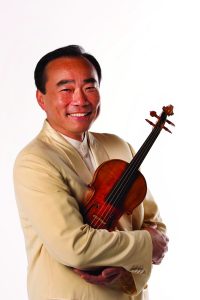SummerFest’s Romantic Opening
La Jolla Music Society’s SummerFest 2012 opened Friday (August 3) with a sumptuous, if slightly exhausting, Romantic music marathon. Wearing his heart on both sleeves—a metaphorical if not a literal possibility—festival Music Director Cho-Liang Lin programmed a nonstop effusion of gorgeous melodies that surfed on waves of opulent harmony.
At the heart of Lin’s program, Soprano Ying Huang gave a striking, passionate account of Rachmaninoff’s familiar “Vocalise,” with Jeffrey Kahane deftly assisting at the piano, and an emotionally charged interpretation of Heitor Villa-Lobos’ “Bachianas Brasilieras No. 5 for Soprano and Eight Cellos.” With a radiant voice of considerable power throughout her range, this confident singer from Shanghai balances the drive of a dramatic soprano with the warmth of a spinto.
Her operatic command projected a playful yet ardent “Dança,” the vivacious, infrequently performed second movement of “Bachianas Brasilieras No. 5.” I admired her dreamy approach to the oft-recorded “Aria,” although in its declamatory middle section I wanted her to convince me that she was actually singing about the “cruel tears and bitter dejection,” that the Portuguese text intones. Does it appear churlish to mention that her final pianissimo high “A,” which the composer cruelly requires the singer to hum, was under pitch?
Nevertheless, Huang, who made her Metropolitan Opera debut in Mozart’s The Magic Flute in 2009, was a welcome addition to the opening night roster.

[Photo (c) Paul Body] SummerFest Music Director Cho-Liang Lin
Their pensive, graceful playing of the Lento assai movement hinted at the deeper thoughts to which Moszkowski aspired, even when his natural inclinations bloomed in the more perfumed style of salon music. The young pianist Henry Kramer accompanied Lin and Hadelich with an unfailingly pellucid touch, and he seamed quite at home in this extravagant late Romantic idiom. He is a member of the Newbury Trio, which will perform later in the festival.
The eight cellists who assisted the soprano in the “Bachianas Brasilieras No. 5” also treated the opening night audience to Villa-Lobos’ “Bachianas Brasilieras No. 1 for Eight Cellos,” a compact, three-movement instrumental opus that explores the compser’s life-long devotion to Latin American folk music and Baroque counterpoint. Under the fleet leadership of first cellist Desmond Hoebig, who offered several sweet, shapely solos, the cellists enthusiastically attacked the folk dance-inspiried opening movement and provided equal verve for the four-voice fugue of the final movement. I can imagine, however, the cello section of a good orchestra giving greater unanimity to the linear aspects of this work.
When pianists Jon Kimura Parker and Jeffrey Kahane launched into Sergei Rachmaninoff’s “Symphonic Danses,” Op 45, I was filled with a rush of enthusiasm. When the composer wrote “Symphonic Danses,” his final orchestral opus, he first composed it as a two piano work, then later filled out the actual orchestration.
As Parker and Kahane applied their adroit piano skills to the first movement, the advantages of this version became immediately apparent: the pianists easily brought out the composer’s laudable linear construction and a gentle, rocking minimalist harmonic palette, aspects of the orchestral version I had noted less distinctly. As the lead piano, Parker boldly captured the work’s grand statements with pianistic bravura and calm assurance, while Kahane’s role was more supportive. I cannot fault their realization of the score.
But as “Symphonic Danses” moved into the middle movement, Tempo di valse, this two piano version only revealed the paucity of ideas the composer brought to the table, a factor his adept orchestration hides quite effectively. As the “Symphonic Dances” came to its conclusion, I was yearning for the colorful sweep and mighty surge of the full orchestra that makes this work beloved by orchestra audiences everywhere.
SummerFest 2012 continues with daily events through Friday, August 24, including open rehearsals, coaching workshops, forums with composers and performers, and concerts. The La Jolla performance venues include Sherwood Auditorium at the Museum of Contemporary Art San Diego, Mandell Weiss Theatre at the La Jolla Playhouse, and St. James by-the-Sea Episcopal Church. For complete information: www.ljms.org or (858) 459-3729.

Ken Herman, a classically trained pianist and organist, has covered music for the San Diego Union, the Los Angeles Times’ San Diego Edition, and for sandiego.com. He has won numerous awards, including first place for Live Performance and Opera Reviews in the 2017, the 2018, and the 2019 Excellence in Journalism Awards competition held by the San Diego Press Club. A Chicago native, he came to San Diego to pursue a graduate degree and stayed.Read more…

“Does it appear churlish” Yes!